Ponte de Cavalos | |
|---|---|
| Coordinates | 40°50′27″N8°20′58″W / 40.84078°N 8.349484°W |
| Locale | Vale de Cambra, Aveiro District, |
| Location | |
 | |
Ponte de Cavalos is a bridge in Portugal. It is located in Vale de Cambra, Aveiro District.
Ponte de Cavalos | |
|---|---|
| Coordinates | 40°50′27″N8°20′58″W / 40.84078°N 8.349484°W |
| Locale | Vale de Cambra, Aveiro District, |
| Location | |
 | |
Ponte de Cavalos is a bridge in Portugal. It is located in Vale de Cambra, Aveiro District.
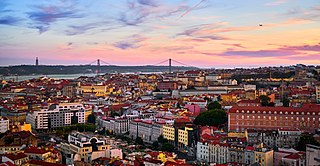
Lisbon is the capital and the largest city of Portugal, with an estimated population of 505,526 within its administrative limits in an area of 100.05 km2. Lisbon's urban area extends beyond the city's administrative limits with a population of around 2.0 million people, being the 10th-most populous urban area in the European Union. About 2.8 million people live in the Lisbon metropolitan area, which represents approximately 27% of the country's population. It is mainland Europe's westernmost capital city and the only one along the Atlantic coast. Lisbon lies in the western Iberian Peninsula on the Atlantic Ocean and the River Tagus. The westernmost portions of its metro area, the Portuguese Riviera, form the westernmost point of Continental Europe, culminating at Cabo da Roca.

The Tagus is the longest river in the Iberian Peninsula. The river rises in the Montes Universales in mid-eastern Spain, flows 1,007 km (626 mi), generally west with two main south-westward sections, to empty into the Atlantic Ocean near Lisbon. Its drainage basin covers 80,100 square kilometers (30,927 sq mi) – exceeded in the peninsula only by the Douro. The river is highly used. Several dams and diversions supply drinking water to key population centres of central Spain and Portugal; dozens of hydroelectric stations create power. Between dams it follows a very constricted course, but after Almourol, Portugal it has a wide alluvial valley, prone to flooding. Its mouth is a large estuary culminating at the major port, and Portuguese capital, Lisbon.
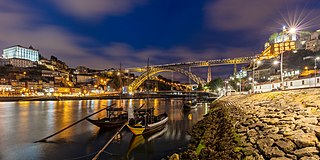
Porto or Oporto is the second-largest city in Portugal and one of the Iberian Peninsula's major urban areas. Porto city is small compared to its metropolitan area, with a population of 237,559 people. Porto's metropolitan area has an estimated 1.7 million people (2019) in an area of 2,395 km2 (925 sq mi), making it the second-largest urban area in Portugal. It is recognized as a global city with a Gamma + rating from the Globalization and World Cities Research Network.

The Carnation Revolution, also known as the 25 April, was initially a 25 April 1974 military coup in Lisbon which overthrew the authoritarian Estado Novo regime. The revolution began as a coup organised by the Armed Forces Movement, composed of military officers who opposed the regime, but it was soon coupled with an unanticipated, popular civil resistance campaign. The revolution led to the fall of the Estado Novo, terminated the Portuguese Colonial War, and started a revolutionary process that would result in a democratic Portugal.

Chaves is a city and a municipality in the north of Portugal. It is 10 km south of the Spanish border and 22 km south of Verín (Spain). The population in 2011 was 41,243, in an area of 591.23 km2. The municipality is the second most populous of the district of Vila Real. With origins in the Roman civitas Aquæ Flaviæ, Chaves has developed into a regional center. The urban area has 17,535 residents (2001).

Trajan's Bridge is a Roman bridge in the civil parish of Santa Maria Maior, in the municipality of Chaves in the Portuguese northern subregion of Terras de Trás-os-Montes.

Olivenza or Olivença is a town situated on an historically disputed section of the Portugal–Spain border. Its territory is administered by Spain as a municipality belonging to the province of Badajoz, and to the wider autonomous community of Extremadura.

The Macau Peninsula is the most populous and historic part of Macau. It has an area of 8.5 square kilometers (3.3 sq mi) and is geographically connected to Guangdong province at the northeast through an isthmus 200 meters (660 ft) wide. The peninsula, together with downtown Zhuhai, sits on an island separated from the continent by distributaries of the Pearl River. The Border Gate was built on the northern isthmus. At the south, the peninsula is connected to Taipa Island by three bridges, the Friendship Bridge ; the Macau-Taipa Bridge ; and the Sai Van Bridge . The longest axis extends 4 kilometers (2.5 mi) from the Border Gate to the southwestern edge, Barra (媽閣嘴). There is a western "Inner Harbor" (內港) paralleled by an "Outer Harbor" (外港) to the east. The 93 meters (305 ft) Guia Hill (松山) is the highest point on the peninsula, which has an average elevation of 50 to 75 meters. Many coastal places are reclaimed from the sea. The Historic Center of Macau, which is entirely on the Macau Peninsula, became a World Heritage Site in 2005.
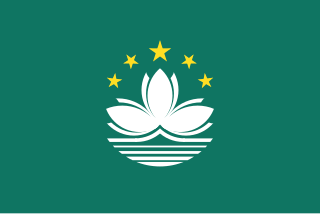
The Regional flag of the Macau Special Administrative Region of the People's Republic of China is light green with a lotus flower above the stylised Governador Nobre de Carvalho Bridge and water in white, beneath an arc of five golden five-pointed stars: one large star in the center of the arc with two smaller stars on each side of the large star.

The 25 de Abril Bridge is a suspension bridge connecting the city of Lisbon, capital of Portugal, to the municipality of Almada on the left (south) bank of the Tagus river. It was inaugurated on August 6, 1966. It is often compared to the Golden Gate Bridge in San Francisco, because they are both suspension bridges of similar color. It was built by the American Bridge Company which constructed the San Francisco–Oakland Bay Bridge but not the Golden Gate. With a total length of 2,277 metres (7,470 ft), it is the 43rd largest suspension bridge in the world.

The Arrábida Bridge is an arch bridge of reinforced concrete which carries six lanes of traffic over the Douro River, between Porto and Vila Nova de Gaia, in the Norte region of Portugal.

Cachoeira is an inland municipality of Bahia, Brazil, on the Paraguaçu River. The town exports sugar, cotton, and tobacco and is a thriving commercial and industrial centre.
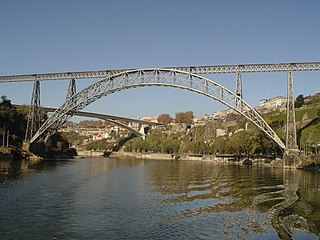
The Maria Pia Bridge is a railway bridge built in 1877, and attributed to Gustave Eiffel, situated over the Portuguese northern municipalities of Porto and Vila Nova de Gaia.

Amarante is a municipality and municipal seat in the Tâmega e Sousa subregion in northern Portugal. The population in 2011 was 56,264, in an area of 301.33 square kilometres (116.34 sq mi). The city itself had a population of 11,261 in 2001. The city has been part of the UNESCO Creative Cities Network under the category of City of Music since 2017.

The Dom Luís I Bridge, or Luís I Bridge, is a double-deck metal arch bridge that spans the River Douro between the cities of Porto and Vila Nova de Gaia in Portugal. At its construction, its 172 metres (564 ft) span was the longest of its type in the world. It has been confused with the nearby Maria Pia Bridge, a railway bridge that was built 9 years earlier, which is similar in aspect to the Luís I bridge.
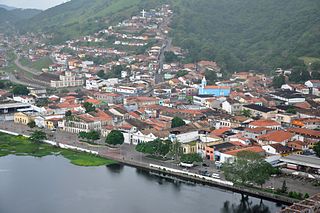
São Félix, Bahia is a municipality in Bahia, Brazil. The municipality has a population of 14,762 with a population density of 142 inhabitants per square kilometer. It is located 110 km (68 mi) from the state capital of Bahia, Salvador.

The Bridge of Cava da Velha is a Roman bridge, situated in the civil parish of Castro Laboreiro e Lamas de Mouro, in the municipality of Melgaço in northern Portuguese district of Viana do Castelo.
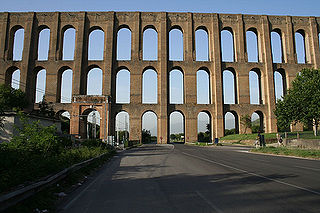
Aqueducts or water bridges are bridges constructed to convey watercourses across gaps such as valleys or ravines. The term aqueduct may also be used to refer to the entire watercourse, as well as the bridge. Large navigable aqueducts are used as transport links for boats or ships. Aqueducts must span a crossing at the same level as the watercourses on each end. The word is derived from the Latin aqua ("water") and ducere, therefore meaning "to lead water". A modern version of an aqueduct is a pipeline bridge. They may take the form of tunnels, networks of surface channels and canals, covered clay pipes or monumental bridges.
The Brazilian Bridge Federation is the national organization for bridge in Brazil and a member of the Confederacion Sudamericana de Bridge and the World Bridge Federation. It was founded in 1945 as the Confederação Brasileira de Bridge, affiliated with the World Bridge Federation in 1979, and fully recognized by it in June 1999.
Infraestruturas de Portugal, S.A. (IP) is a state-owned company which resulted from the merger of Rede Ferroviária Nacional (REFER) and Estradas de Portugal (EP). It manages the Portuguese rail and road infrastructure.